At Comfort Solutions, our top priority for all our custom fireplace models is safety. From our gas fireplaces to every contemporary fireplace option we have in stock, we build in specific safety components that are meant to be simple, self-explanatory and easily maintained by all our clients.
No matter how many safety precautions we or you take for your fireplace, however, we strongly recommend you maintain an appropriate number of smoke alarms within your home or building at all times. This is not just for fireplace usage alone, but for other fire risks as well – a majority of fire deaths of all types take place in homes with no working smoke alarms. With this in mind, let’s go over several important areas you should be considering when it comes to your smoke alarms.
Installation and System Connections
Some general tips and themes to consider when it comes to choosing your smoke alarm system and installing it:
- Interconnected system: If you’re purchasing an all-new smoke alarm system for a home or building, look for interconnected alarm systems. These are systems where one a single smoke alarm sounds, all of the alarms in the building sound simultaneously, allowing occupants of any area to evacuate safely.
- Location: We highly recommend installing smoke alarms in every bedroom of a home, plus outside each sleeping area. Every level of a given home should have multiple alarms, including the basement.
- For larger homes, a greater number of alarms may be necessary.
- Placement: Generally speaking, smoke alarms should be placed on ceilings or high up on your walls. Kitchen placement is important – keep alarms at least 10 feet from the stove so no false alarms are triggered, but be sure the kitchen still has alarms in case of a fire.
Smoke Alarm System Options
There are several different alarm system options out there today, from traditional choices to more modern styles with advanced technology. Some are meant to detect both smoke and carbon monoxide all in one item, for instance. Other systems have built-in false alarm detectors, while still other new items on the market can respond to multiple fire conditions with different patterns. Finally, for anyone who struggles with hearing or is deaf, there are special alarm systems available that utilize strobe lights, bed shakers and other indicators to help assist you.
Testing and Replacement
You should be testing your smoke alarms at least once a month, generally using the test button located on all alarm systems. If you begin to notice regular issues during these tests that aren’t simply related to failing batteries, or if your alarm system is reaching 10 years of age or greater, you might consider replacing either individual alarms or even the entire system.
For more on smoke alarms in your home or building, or to learn about any of our modern fireplace systems and how to stay safe at all times around them, speak to the staff at Comfort Solutions today.


